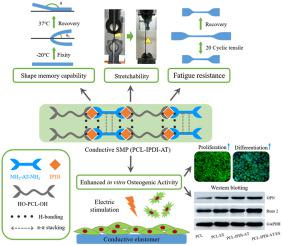当前位置:
X-MOL 学术
›
Polym. Test.
›
论文详情
Our official English website, www.x-mol.net, welcomes your feedback! (Note: you will need to create a separate account there.)
Conductive stretchable shape memory elastomers combining with electrical stimulation for synergistic osteogenic differentiation
Polymer Testing ( IF 5.1 ) Pub Date : 2020-10-01 , DOI: 10.1016/j.polymertesting.2020.106672 Huanhuan Yan , Linlong Li , Xincui Shi , Jui-Ming Yeh , Yen Wei , Peibiao Zhang
Polymer Testing ( IF 5.1 ) Pub Date : 2020-10-01 , DOI: 10.1016/j.polymertesting.2020.106672 Huanhuan Yan , Linlong Li , Xincui Shi , Jui-Ming Yeh , Yen Wei , Peibiao Zhang

|
Abstract The natural extracellular matrix (ECM) possessed varying biomechanical properties which played important roles in the dynamic cellular microenvironment. However, for the conventional bone tissue engineering scaffolds, stretchability and shape memory property were normally absent. Thus, the behaviors of responsive changes required in dynamic physiological settings were unsatisfactory. Herein, a series of conductive polyurethane shape memory elastomers (PCL-IPDI-AT) were synthesized, which based on conductive amino capped aniline trimer (AT), isophorone diisocyanate (IPDI) and poly(ԑ-caprolactone) (PCL). The conductive elastomers possessed high elasticity and flexibility, especially, the breaking elongation of copolymer with 15% AT content was up to 570 ± 56%. The mechanical properties of elastomers could be adjusted by regulating the content of AT in copolymers. The conductive elastomers exhibited excellent shape fixity ratio and good shape recovery ability at 37 °C. The electrical conductivity of elastomers was measured via the standard van der Pauw four-probe method. They were all around 10−7 S/cm and similar to that in human physiological environments. On the one hand, excellent cytocompatibility was demonstrated by the viability and proliferation results of MC3T3-E1 pre-osteoblasts seeded on the elastomer. On the other hand, the elastomer could synergistically promote the osteogenic differentiation compared to PCL in terms of ALP activity, calcium deposition, and bone-related protein and gene expression levels as combined with electrical stimulation (ES). Specifically, the ALP activity for conductive elastomer under ES was notably improved by 1.4-fold compared to PCL at 7 days. Overall, the conductive elastomers displayed excellent stretchability, shape memory property, fatigue resistance and osteogenic bioactivity. They may be applied as bone substitutes for electrical-signal-sensitive bone tissue engineering.
中文翻译:

导电可拉伸形状记忆弹性体结合电刺激协同成骨分化
摘要 天然细胞外基质(ECM)具有不同的生物力学特性,在动态细胞微环境中发挥着重要作用。然而,对于传统的骨组织工程支架,通常不具备拉伸性和形状记忆特性。因此,动态生理环境中所需的响应变化的行为并不令人满意。在此,基于导电氨基封端苯胺三聚体(AT)、异佛尔酮二异氰酸酯(IPDI)和聚(己内酯)(PCL)合成了一系列导电聚氨酯形状记忆弹性体(PCL-IPDI-AT)。导电弹性体具有高弹性和柔韧性,尤其是AT含量为15%的共聚物的断裂伸长率高达570±56%。弹性体的力学性能可以通过调节共聚物中AT的含量来调节。导电弹性体在 37°C 下表现出优异的形状固定率和良好的形状恢复能力。通过标准范德堡四探针法测量弹性体的电导率。它们都在 10−7 S/cm 左右,与人类生理环境中的相似。一方面,接种在弹性体上的 MC3T3-E1 前成骨细胞的活力和增殖结果证明了优异的细胞相容性。另一方面,在 ALP 活性、钙沉积以及骨相关蛋白和基因表达水平方面,与电刺激 (ES) 相结合,与 PCL 相比,弹性体可以协同促进成骨分化。具体来说,与 PCL 相比,ES 下导电弹性体的 ALP 活性在 7 天时显着提高了 1.4 倍。总体而言,导电弹性体显示出优异的拉伸性、形状记忆性能、抗疲劳性和成骨生物活性。它们可用作电信号敏感骨组织工程的骨替代品。
更新日期:2020-10-01
中文翻译:

导电可拉伸形状记忆弹性体结合电刺激协同成骨分化
摘要 天然细胞外基质(ECM)具有不同的生物力学特性,在动态细胞微环境中发挥着重要作用。然而,对于传统的骨组织工程支架,通常不具备拉伸性和形状记忆特性。因此,动态生理环境中所需的响应变化的行为并不令人满意。在此,基于导电氨基封端苯胺三聚体(AT)、异佛尔酮二异氰酸酯(IPDI)和聚(己内酯)(PCL)合成了一系列导电聚氨酯形状记忆弹性体(PCL-IPDI-AT)。导电弹性体具有高弹性和柔韧性,尤其是AT含量为15%的共聚物的断裂伸长率高达570±56%。弹性体的力学性能可以通过调节共聚物中AT的含量来调节。导电弹性体在 37°C 下表现出优异的形状固定率和良好的形状恢复能力。通过标准范德堡四探针法测量弹性体的电导率。它们都在 10−7 S/cm 左右,与人类生理环境中的相似。一方面,接种在弹性体上的 MC3T3-E1 前成骨细胞的活力和增殖结果证明了优异的细胞相容性。另一方面,在 ALP 活性、钙沉积以及骨相关蛋白和基因表达水平方面,与电刺激 (ES) 相结合,与 PCL 相比,弹性体可以协同促进成骨分化。具体来说,与 PCL 相比,ES 下导电弹性体的 ALP 活性在 7 天时显着提高了 1.4 倍。总体而言,导电弹性体显示出优异的拉伸性、形状记忆性能、抗疲劳性和成骨生物活性。它们可用作电信号敏感骨组织工程的骨替代品。


























 京公网安备 11010802027423号
京公网安备 11010802027423号